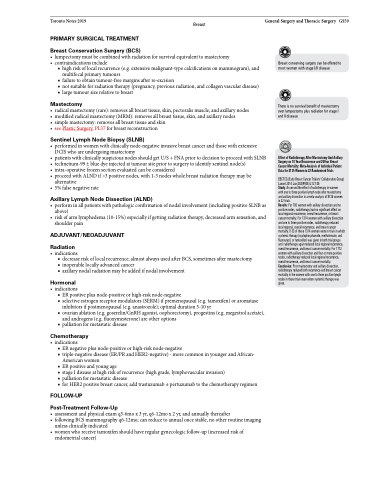Page 461 - TNFlipTest
P. 461
Toronto Notes 2019 Breast PRIMARY SURGICAL TREATMENT
Breast Conservation Surgery (BCS)
• lumpectomymustbecombinedwithradiationforsurvivalequivalenttomastectomy • contraindicationsinclude
■ high risk of local recurrence (e.g. extensive malignant-type calcifications on mammogram), and multifocal primary tumours
■ failure to obtain tumour-free margins after re-excision
■ not suitable for radiation therapy (pregnancy, previous radiation, and collagen vascular disease)
■ large tumour size relative to breast
Mastectomy
• radicalmastectomy(rare):removesallbreasttissue,skin,pectoralismuscle,andaxillarynodes • modifiedradicalmastectomy(MRM):removesallbreasttissue,skin,andaxillarynodes
• simplemastectomy:removesallbreasttissueandskin
• seePlasticSurgery,PL37forbreastreconstruction
Sentinel Lymph Node Biopsy (SLNB)
• performedinwomenwithclinicallynode-negativeinvasivebreastcancerandthosewithextensive DCIS who are undergoing mastectomy
• patients with clinically suspicious nodes should get U/S + FNA prior to decision to proceed with SLNB
• technetium-99±bluedyeinjectedattumoursitepriortosurgerytoidentifysentinelnode(s)
• intra-operative frozen section evaluated can be considered
• proceedwithALNDif>3positivenodes,with1-3nodeswholebreastradiationtherapymaybe
alternative
• 5% false negative rate
Axillary Lymph Node Dissection (ALND)
• performinallpatientswithpathologicconfirmationofnodalinvolvement(includingpositiveSLNBas above)
• riskofarmlymphedema(10-15%)especiallyifgettingradiationtherapy,decreasedarmsensation,and shoulder pain
ADJUVANT/NEOADJUVANT
Radiation
• indications
■ decrease risk of local recurrence; almost always used after BCS, sometimes after mastectomy ■ inoperable locally advanced cancer
■ axillary nodal radiation may be added if nodal involvement
Hormonal
• indications
■ ER positive plus node-positive or high-risk node-negative
■ selective estrogen receptor modulators (SERM) if premenopausal (e.g. tamoxifen) or aromatase
inhibitors if postmenopausal (e.g. anastrozole); optimal duration 5-10 yr
■ ovarian ablation (e.g. goserelin/GnRH agonist, oophorectomy), progestins (e.g. megestrol acetate),
and androgens (e.g. fluoxymesterone) are other options
■ palliation for metastatic disease
Chemotherapy
• indications
■ ER negative plus node-positive or high-risk node-negative
■ triple-negative disease (ER/PR and HER2-negative) - more common in younger and African-
American women
■ ER positive and young age
■ stage I disease at high risk of recurrence (high grade, lymphovascular invasion)
■ palliation for metastatic disease
■ for HER2 positive breast cancer, add trastuzumab ± pertuzumab to the chemotherapy regimen
FOLLOW-UP
Post-Treatment Follow-Up
• assessmentandphysicalexamq3-6mox3yr,q6-12mox2yr,andannuallythereafter
• followingBCSmammographyq6-12mo;canreducetoannualoncestable,nootherroutineimaging
unless clinically indicated
• womenwhoreceivetamoxifenshouldhaveregulargynecologicfollow-up(increasedriskof
General Surgery and Thoracic Surgery GS59
Breastconservingsurgerycanbeofferedto most women with stage I/II disease
There is no survival benefit of mastectomy overlumpectomyplusradiationforstageI andIIdisease
Effect of Radiotherapy After Mastectomy And Axillary Surgery on 10 Year Recurrence and 20Year Breast Cancer Mortality: Meta-Analysis of Individual Patient Data for 8135 Women in 22 Randomised Trials
EBCTCG (Early Breast Cancer Trialists' Collaborative Group) Lancet 2014 Jun;383(9935):2127-35
Study: Assessed the effect of radiotherapy in women with one to three positive lymph node after mastectomy and axillary dissection in a meta-analysis of 8135 women in 22 trials.
Results: For 700 women with axillary dissection and no positive nodes, radiotherapy had no significant effect on local regional recurrence, overall recurrence, or breast cancer mortality. For 1314 women with axillary dissection and one to three positive nodes, radiotherapy reduced
local regional, overall recurrence, and breast cancer mortality.1133 of these 1314 women were in trials in which systemic therapy (cyclophosphamide, methotrexate, and fluorouracil, or tamoxifen) was given in both trial groups and radiotherapyagainreducedlocalregionalrecurrence, overall recurrence, and breast cancer mortality. For 1772 women with axillary dissection and four or more positive nodes, radiotherapy reduced local regional recurrence, overall recurrence, and breast cancer mortality. Conclusion: Post mastectomy and axillary dissection, radiotherapy reduced both recurrence and breast cancer mortality in the women with one to three positive lymph nodes in these trials even when systemic therapy was given.
endometrial cancer)


